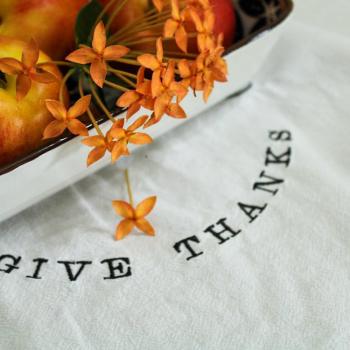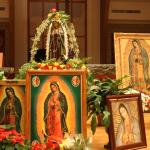
On Holy Thursday I went to Mass, and that wasn’t bad.
My religious trauma panic attacks are getting a little better. The church was full to bursting, impossibly full, so Adrienne and I were crammed in the back with scarcely room to breathe. I wasn’t afraid at all at Holy Communion. I only shuddered a little when I had to walk past the Franciscan sisters and their three-knot belts, though the sight of a Franciscan can often set my heart racing. We got through the Pangae Lingua four times before the church had finished processing to the altar of repose, and then the line to wait an hour with Jesus was out the door. I stopped for a second to kiss the wall of the chapel before I gave up and went home.
On Good Friday I didn’t feel up for a liturgy. I decided to go hiking by myself.
I can hear the voice of God so much more clearly while hiking than in church.
I didn’t feel like going to the Mineral Spring again, but I felt like being near a body of water. I drove all the way out to Jefferson Lake, where the trees had barely budded yet but the wildflowers were up. Little white spring beauty popped out of every muddy embankment, reminding me again and again that resurrection is normal. It’s not unusual at all. It happens every year. The sun comes back. The gray void of February warms to the gold of March and the green of April. First the moss brightens and then the grass. The birds return and the mammals wake up. The trees blossom and the wildflowers bloom. Resurrection is a part of nature. One of the meanings of the Passion, Death and Resurrection of Christ is that God became a part of nature so that Nature could be taken up into God.
Crows were making noise in the trees across the lake as I set out. Corvids are birds that sound alarmingly like human beings imitating birds. It sounded like a pair of angry Appalachian people were jeering at each other from the picnic shelter house. Maybe the birds were fighting. Maybe they were mating. Maybe they were crying “Eloi, Eloi, lama sabachthani” and “If you are the Son of Man, come down,” in honor of the day.
When I got to that spot on the trail, I saw them. A hawk swooped overhead, light gray against a vibrant blue sky, majestic, regal, reminding me of that sentimental psalm about eagles’ wings. Then two crows flew after him, black against the blue, one on each side. They all swooped around above me, the pinions outspread like three crosses, reminding me of the Gospel: except that, instead of an innocent Man between two robbers, it was a robber between two righteous carrion birds. Hawks will go after just about any kind of nest. They will eat crow eggs, and crows. The crows were defending their own lives and their future children against the more majestic bird, and they were fighting dirty. First, the crow on the right side darted at the hawk, sharp beak flashing like a dagger; the hawk seemed to roll in midair, and then the crow on the left snatched with angry claws. They took turns, ganging up mercilessly on the apex predator, until they chased it out of my sight.
In the fight against every false Christ who looks just right but comes to prey on the innocent, may we all be dirty Appalachian crows. Amen.
On Holy Saturday, somewhere between all the shopping and the baking and cleaning the house, I found out that the Lost Girl had been arrested.
I’d seen the dumpster in front of her house when I was driving to Mass on Palm Sunday. I didn’t feel the grief rolling in until I saw the little girls’ plastic playhouse roof sticking out of the pile of garbage. But now her name was on the sheriff’s social media with all the other weekend jail book-ins, and I felt something worse.
Someone told me to stop blaming myself as if I had the presence of mind to blame myself in the first place. There wasn’t a feeling as coherent as blame. There was just a tearing in my gut, as if a hawk had struck me there with outstretched claws, and I felt it all day.
We went to that terribly crowded church once more, for the Easter vigil in the holy night.
I don’t think I had a moment to process my grief until I heard the choir chanting that song that’s haunted me for well over a year now: Vidi aquam egredientem de templo, a latere dextro, alleluia: et omnes, ad quos pervenit aqua ista, salvi facti sunt, et dicent, alleluia, alleluia. I saw water coming from the right side of the temple, alleluia, and all to whom the water came were saved. Alleluia, alleluia.
It continues to flow, whether I can believe it or not, whether anyone notices or not, whether the messiah you thought you had to follow is the right one or another Antichrist.
One of the meanings of the Resurrection is that all of this: liturgy and nature, crows and eagles, failure and blame and nothing ever going the way that it ought, is taken up into the Life of the Holy Trinity, and so am I.
Sometimes I wish for a simpler, crueler deity who can make it all make sense. But the only god I have ever met is the God Who dwells in my own life with me. Not the idol of the Prosperity Gospel, Franciscan University and the Charismatic Renewal, but the God of crows and eagles, streams of water, dilapidated Appalachian neighborhoods, of kind people like Jimmy and The Lady of LaBelle and of codependent failures like me.
Next thing I knew, it was the Communion meditation, and by a freak coincidence the choir sang the song that had been the bridal entry hymn they’d played at my complicated wedding. I flashed back for a moment to the great big Baroque traditionalist church downtown, when I was still trying so hard to be a part of the cult and still a student at Franciscan University. And I was out on the church porch, shuddering in the night. But it wasn’t a bad shudder, because God was with me.
It wasn’t a bad Triduum.
It hasn’t been a bad Easter.
And I’m thankful to all of you for accompanying me.
Mary Pezzulo is the author of Meditations on the Way of the Cross, The Sorrows and Joys of Mary, and Stumbling into Grace: How We Meet God in Tiny Works of Mercy.

















